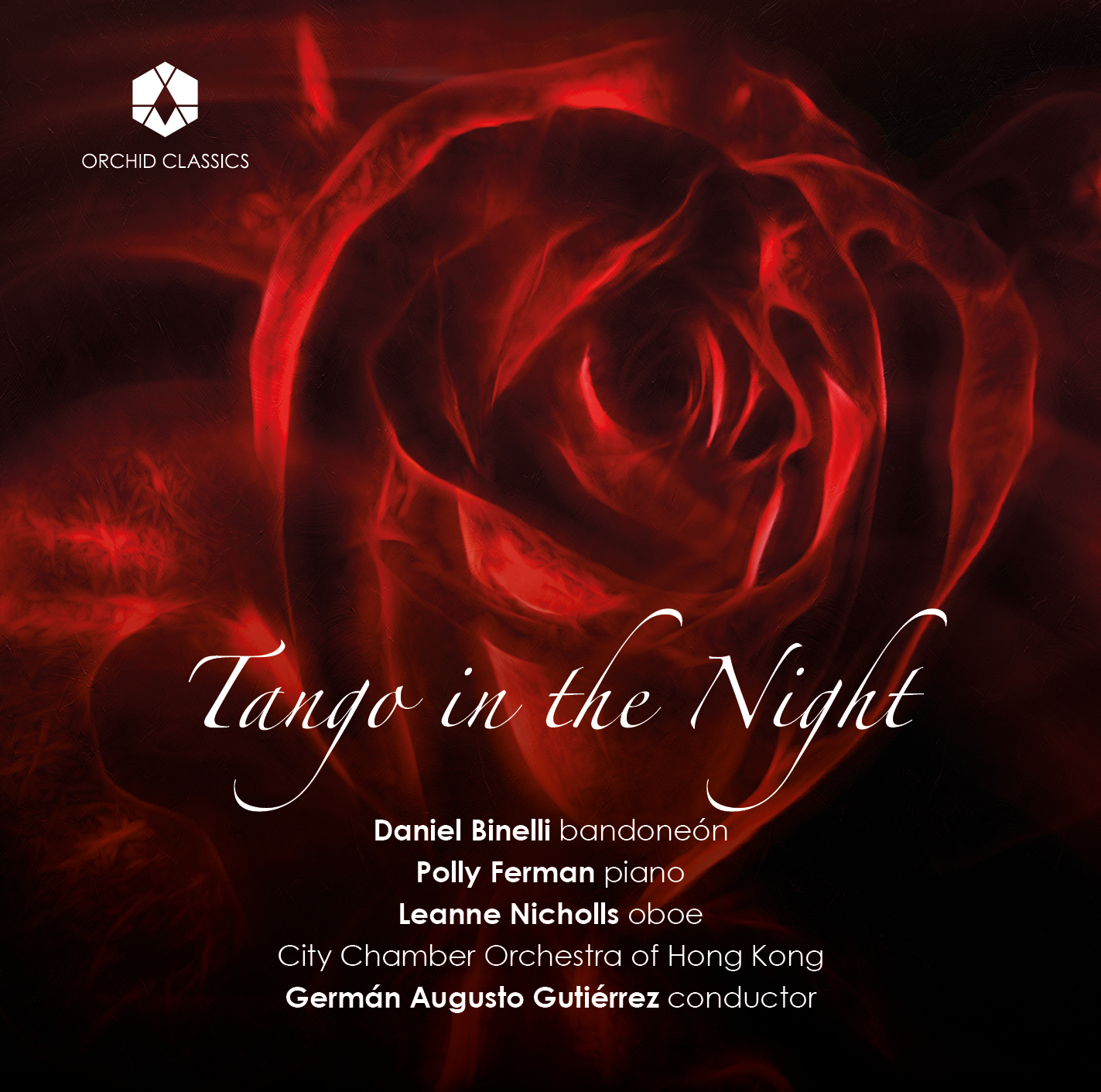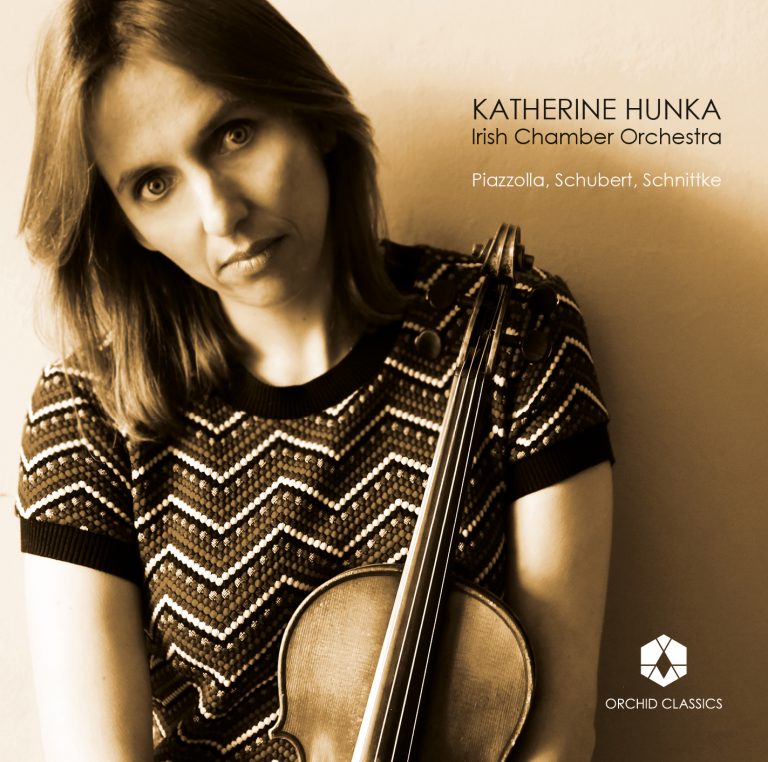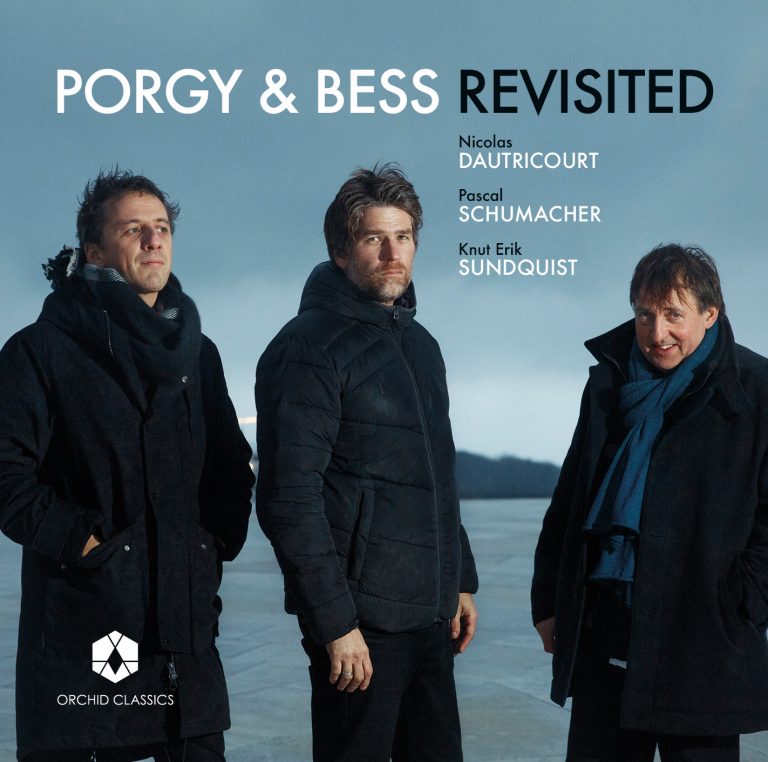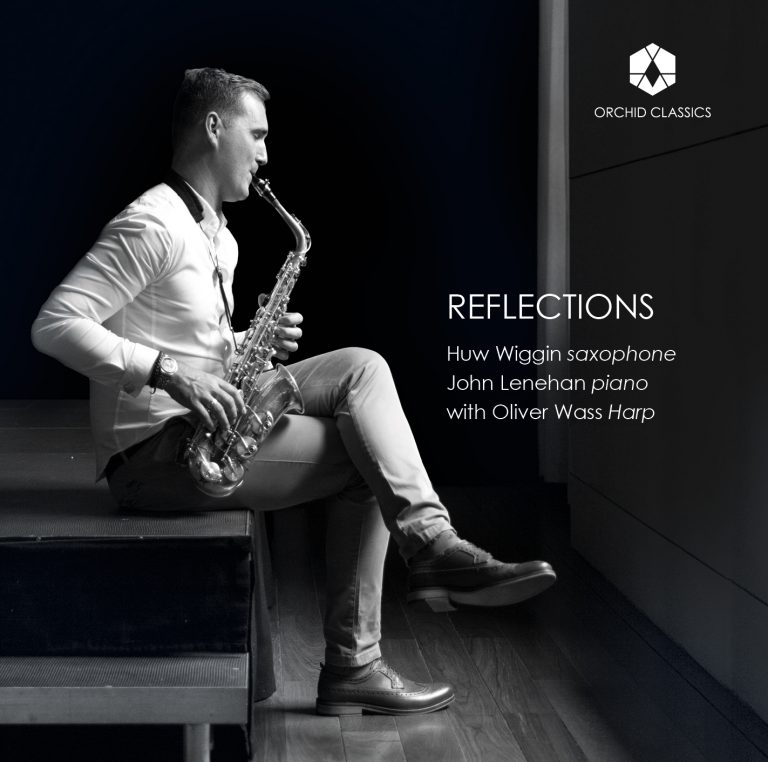Artist Led, Creatively Driven

Tango in the Night
Daniel Binelli bandoneón
Polly Ferman piano
Leanne Nicholls oboe
City Chamber Orchestra of Hong Kong
Germán Augusto Gutiérrez conductor
Release Date: 19th March
ORC100160
TANGO IN THE NIGHT
Ángel Villoldo (1861-1919)
1 El Choclo* 4.31
Mariano Mores (1918-2016)
2 Tanguera* 2.16
Astor Piazzolla (1921-1992)
3 Libertango* 3.44
Astor Piazzolla
4 Oblivion 3.51
Leanne Nicholls oboe
Daniel Binelli (b.1946)
5 Tango in the Night 7.12
Astor Piazzolla
6 Fracanapa* 3.13
Astor Piazzolla
7 Verano Porteño* 6.31
Binelli-Ferman Duo
Horacio Salgán (1916-2016)
8 Don Agustín Bardi* 3.16
Aníbal Troilo (1914-1975)
9 Responso* 3.46
Julián Plaza (1928-2003)
10 Nocturna* 3.06
Anselmo Aieta (1896-1964)
11 Palomita Blanca* 2.57
Daniel Binelli
12 Tango de los Cuadros* 3.34
Binelli-Ferman Duo
Matos Rodríguez (1897-1948)
13 La Cumparsita* 3.26
* Arrangements by Daniel Binelli
Total time 45.20
Daniel Binelli bandoneón
Polly Ferman piano
Leanne Nicholls oboe
City Chamber Orchestra of Hong Kong
Germán Augusto Gutiérrez conductor
Tango in the Night
The Binelli-Ferman Duo and oboist Leanne Nicholls join City Chamber Orchestra of Hong Kong conducted by Germán Augusto Gutiérrez in this exhilarating compilation of tango arrangements by Daniel Binelli. Each work on this album holds a chapter in the evolution of the tango, from its waterfront roots in the night-time taverns of the Río de la Plata (Buenos Aires and Montevideo) to the concert halls of today. Moreover, the bandoneón, the instrument that symbolizes the tango and permeates its history, takes the spotlight. The journey begins with Ángel Villoldo’s El Choclo, the best-known tango from the early 1900s and the era known as ‘La Guardia Vieja’ (The Old Guard). Here we experience a type of habanera blended with European music. Palomita Blanca, a waltz with lyrics by Francisco Garcia Gimenez, represents the romantic phase of the 1920s and 1930s when the great poets started writing words for the tango. During this time tango became immensely fashionable in European society. We then move to the 1940s when the grandiose dance halls became a hub for the big-time tango orchestras of Aníbal Troilo, Osvaldo Pugliese, Carlos di Sarli and Juan D’Arienzo. Around this period the sound of the bandoneón became inextricably linked to tango. In the 1950s Mariano Mores introduced new instruments to the tango including organ, keyboard, drums and bass. Horacio Salgán, a classically-trained pianist, became a transitional figure between the classic tango of the 1940s and the avant-garde style. Liberated from the need to please dancers, he achieved a brilliant balance between tradition and innovation, and further established the importance of the piano in tango music. In the 1960s the great Astor Piazzolla emerged as a revolutionary force in the tango world. He blended elements of classical and jazz in his music and shocked the traditionalists with his revolutionary ‘tango nuevo’ for the concert hall. From the 1990s we have Daniel Binelli who is the torchbearer of Piazzolla. His works represent the sound of tango today. Our tango journey ends fittingly with a step backwards to 1917 in Matos Rodríguez’s La Cumparsita, a tango traditionally played as the last dance of the evening.
Ángel Villoldo was a poet and a singer who published a large collection of creole folksongs and popular Argentine songs. Composed in 1903, El Choclo (The Ear of Corn) holds a memorable place in the history of the tango. Its irresistible rhythm and melody led to a first performance by a classical orchestra in an exclusive restaurant, where it posed as a creole dance. Ángel Villoldo’s lyrics describe the ear of corn as the tastiest ingredient of the puchero, a popular meat and vegetable stew in Argentina. Earning a living was generally referred to as ‘earning the puchero’, and Ángel Villoldo hoped that the success of his composition would bring food to his table. His dream came true as El Choclo became a classic, selling over 30,000 copies!
Mariano Mores was a performer and composer who worked with some of the most famous tango orchestras of his day. He wrote soundtracks for various films and took roles in some classic movies. In 1948 he founded Orquesta de Cámara del Tango and Orquesta Lírica and later the modern tango sextet, and with these ensembles introduced new instruments to the tango. In 2000 Mariano Mores was voted Best Tango Composer of the Century by the local authorities in Argentina. His Tanguera with its surging melody offers a heady mix of bandoneón, piano and pizzicato strings.
Bandoneónist, bandleader and composer/arranger, Daniel Binelli has successfully extended the new music of Buenos Aires through his modern collaborations with classical, jazz and rock musicians. Composed in 2008 and premiered in Hong Kong in 2010, Tango in the Night also features on the soundtrack to the Indie feature film Tango Shalom. Written in the style of a European tango, the work depicts the mystery, the romance and the nightlife bustle of Buenos Aires, a city where tourists and locals mingle at milongas held at street cafes, restaurants and bars until dawn. The mood swings from seductive to playful and stirring, and the entire work concludes with a well-known melody called a milonga-candombe. On this recording we also hear Daniel Binelli’s Tango de los Cuadros for bandoneón and piano duo, composed in 1998 as a hommage to Osvaldo Pugliese.
Julián Plaza was a well-known player of the piano and the bandoneón and a composer/arranger. He was interested in the evolution and progression of the tango and wrote works in a style influenced by Piazzolla which were performed by the famous Aníbal Troilo and Osvaldo Pugliese Orchestras. In 1968 Julián Plaza founded the Sexteto Tango for whom he wrote the soundtracks for two films. His Nocturna takes the form of a milonga with an urban flavour.
Horacio Salgán was an outstanding pianist who started his career playing for silent movies before joining the Orquesta Típica Roberto Firpo. In 1944 he set up his own ensemble comprising four bandoneóns, piano, strings and a singer. This gave him the possibility to experiment as a composer and go on to pioneer a new style. In the 1960s he formed his Quinteto Real which performed sophisticated instrumental tangos designed for listening rather than dancing. In addition to elevating the traditional tango to the status of solo and chamber music, Horacio Salgán’s works show influences from jazz, Brazilian folk music and classical composers including Béla Bartók and Gioachino Rossini. Written in 1947, Don Agustín Bardi is considered to be one of Horacio Salgán’s most well-known compositions.
Anselmo Aieta was a leading bandoneón player and a prodigious composer. A traditionalist, he resisted the new revolutionary ways of bandoneón playing. His own orchestra employed some prominent tango musicians, and was in great demand for performances in cafes, cinemas and clubs. Besides tangos, Anselmo Aieta composed music of other genres including waltzes, pasodobles, zambas and milongas. His works were highly acclaimed for their spontaneity and originality, and were performed regularly by the most successful orchestras of the time including those of Aníbal Troilo, Osvaldo Pugliese and Fransisco Canaro. Palomita Blanca (Little White Dove) is a waltz composed by Anselmo Aieta in 1929.
Aníbal Troilo was a legendary bandleader and bandoneónist who defined the instrument for his generation with his expressive playing. He not only devoted himself to preserving the tradition of the sentimental tango but also exercised a strong influence on its development, advancing the style of his forebears and establishing the sound many consider to be classic tango. In the 1940s his orchestra was renowned for its instrumentalists and was the preferred choice of social dancers. Astor Piazzolla, a fan of the Aníbal Troilo orchestra, became a member and had a number of his pieces played by the ensemble. After Aníbal Troilo’s death Piazzolla composed a suite dedicated to his memory called Troileana. Revered today as the “last living myth of the tango”, Aníbal Troilo left a small output of romantic melodies as illustrated in Responso.
Astor Piazzolla was a virtuoso of the bandoneón who held a life-long identity with the tango and its evolution. After studying composition with Nadia Boulanger in Paris, he returned to Argentina where he infused the indigenous tango with infectious melodies, lively rhythms, chromaticism, dissonance, and jazz elements. This new and revolutionary type of intoxicating dance, known as ‘tango nuevo’ initially met with some hostility by the traditionalists. Today, however, it is widely acknowledged that Astor Piazzolla’s influence rescued the tango from inevitable decline. Libertango, a song to liberty, was written in Rome in 1947 when Astor Piazzolla was experimenting with inventive instrumentation towards a more commercial, rock and jazz-influenced sound. Percussive and relentlessly urgent, the bandoneón takes a central role in Daniel Binelli’s breathtaking arrangement. Oblivion is one of the most memorable pieces of music from Marco Bellocchio’s screen adaptation of Luigi Pirandello’s classic play Enrico IV (Henry IV) released in 1984. Scored for solo oboe and strings, its compellingly nostalgic tune has made it one of Astor Piazzolla’s greatest tango masterpieces. Composed in 1963, Fracanapa is a dance reminiscent of the milonga and was a popular inclusion in concert programmes throughout Astor Piazzolla’s career. It is a typical example of the composer’s exploration of percussive rhythms and dissonant sounds. Astor Piazzolla’s Verano Porteño (Summer) is derived from The Four Seasons of Buenos Aires Suite composed in 1964. Daniel Binelli’s adaptation for bandoneón and piano duo was created to showcase the two instruments on an equal footing with the inclusion of some improvisation in the new tango style.
Matos Rodríguez was a Uruguayan pianist and composer who wrote incidental pieces for the theatre in Buenos Aires and music for film scores. For a brief time he led his own tango orchestra in his hometown of Montevideo. Composed in 1917, La Cumparsita (The Little Marching Band), remains one of the most famous and recognizable tango songs of all time. It captures the nostalgic and sensual nature of the dance, sometimes insistent, at other times subdued. In 1997 this work was legally named as the cultural anthem of Uruguay. Immensely popular at milongas, La Cumparsita is traditionally played as the last dance of the evening, making for a fitting end to this tango compilation.
© Jane Downer, Polly Ferman, Leanne Nicholls
Daniel Binelli bandoneón
Renowned Argentinean bandoneón player and composer, Daniel Binelli is considered to be the foremost exponent of the modern tango and the torchbearer of his fellow countryman Astor Piazzolla. During the 1980s he worked extensively with Astor Piazzolla, touring as a member of Piazzolla’s New Tango Sextet. As bandoneón soloist he has performed with the Tonhalle Orchestra Zürich, the Calgary and Mexico City Philharmonic Orchestras, the Argentine National Symphony Orchestra and the Chicago, Philadelphia, Atlanta, Montreal, Dallas and Sydney Symphony Orchestras. He has also collaborated with jazz and contemporary greats including Paquito D’Rivera, Lalo Schifrin, Michael Brecker, Gary Burton and the Dizzy Gillespie United Nation Orchestra. Daniel Binelli is the Music Director of Tango Metropolis, a dance and music company touring worldwide. In addition to commissions from soloists, ensembles, tango companies and orchestras from around the world, Daniel Binelli has composed music for Argentine films including India Pravile, Funes un Gran Amor, Tango Baile Nuestro and Tango Shalom. His numerous recordings include Astor Piazzolla’s Concerto for Bandoneón and Guitar with the Montreal Symphony Orchestra under Charles Dutoit and Tres Tangos Sinfónicos with the Nashville Symphony Orchestra conducted by Giancarlo Guerrero. Nominations for the 2018 and 2019 Latin Grammy Awards include Marron y Azul and Nostalgias. As a member of the Binelli-Ferman Duo he has toured worldwide for more than 20 years and produced several recordings including Sax and Tango with the Púrpura Pansa Saxophone Quartet.
Polly Ferman piano
Described by The Japan Times as a “Musical Ambassador of the Americas”,
Polly Ferman has performed extensively as piano soloist with the San Francisco, Colorado and Vancouver Symphony Orchestras, the Tokyo City Philharmonic Orchestra, the Kharkiv Philharmonic Orchestra, the São Paulo State Symphony Orchestra, the Argentine National Symphony Orchestra, the Camerata Romeu String Orchestra in Cuba, and with all the major orchestras in her native Uruguay. She has performed in recital at Carnegie Hall in New York, St Martin-in-the-Fields in London and at the Teatro Colón in Buenos Aires. As a member of the Binelli-Ferman Duo she has toured the world for more than 20 years and produced several recordings including Sax and Tango with the Púrpura Pansa Saxophone Quartet. Performances with Tango Metropolis, Orquestango and the Daniel Binelli Quintet have also taken her on tours to Europe, Japan, Australia and the USA.
A cultural entrepreneur for Latin Amercian music, Polly Ferman has been Founder and Director of the Pan American Musical Art Research since 1984 and the Latin American Cultural Week held annually in New York City since 2006. She has also been at the forefront in the creation of several new productions celebrating women in tango including Leading Ladies of Tango, GlamourTango and the musical Aires de Mujer. Her recordings include an extensive collection of solo piano works by Latin American composers including Ernesto Nazareth, Ernesto Lecuona and Ariel Ramírez.
Leanne Nicholls oboe
Leanne Nicholls is the Founder, Artistic Director and Principal Oboist of City Chamber Orchestra of Hong Kong. She has been at the forefront of classical music programming in Hong Kong since 1990. Her mentors include Czech oboe virtuoso Jiří Tancibudek and Hans Elhorst. She holds a Bachelor of Music degree with First Class Honours from The University of Adelaide and was the winner of the 1988 Adelaide Eisteddfod Non-Keyboard Competition. Her orchestral career in Australia and Asia includes engagements with the Adelaide Symphony Orchestra, the Adelaide Chamber Orchestra, the State Opera Orchestra of South Australia, the Hong Kong Philharmonic Orchestra, the Macao Orchestra and the Hong Kong Sinfonietta. As lyricist and script writer, she has penned WILD The Musical (2021) and Bug Symphony (2015) which received the Public Choice Award at the 2017 YAMawards in Portugal. In 2009 Leanne Nicholls was awarded a commendation certificate by the Secretary for Home Affairs of the Hong Kong SAR Government for her contribution to the development of arts and cultural activities in Hong Kong.
Germán Augusto Gutiérrez conductor
Germán Augusto Gutiérrez has performed as a guest conductor throughout North and South America, Europe, Asia and Oceania. His performances include engagements with the Symphony Orchestras of Fort Worth, Shanghai, Xalapa, and Porto Alegre, the Bogotá and Auckland Philharmonia Orchestras, the Czech National Symphony Orchestra, the South Dakota All-State Orchestra and the National Symphony Orchestras of Peru, Costa Rica and Puerto Rico. He also appears regularly with orchestras in his native Colombia and has been invited as a guest conductor at several prestigious musical festivals including the Ibero American Arts Festival in San Juan (Puerto Rico), the Pergine Spettacolo Aperto Festival in Italy and the International Music Festival in Medellín in Columbia. In 2008 he achieved an unprecedented twelfth year as conductor of the Dallas Symphony Orchestra’s African American and Hispanic Festival. Germán Augusto Gutiérrez is currently Associate Professor at Texas Christian University in Forth Worth, where he also serves as Chair Director of the Centre for Latin American Music and Director of Orchestras. He is the recipient of the 2002 Dean’s Award for Research and Creative Activity and the 2003 Chancellor’s Award for Distinguished Research and Creative Activity, the highest award bestowed by the Texas Christian University.
City Chamber Orchestra of Hong Kong
City Chamber Orchestra of Hong Kong (CCOHK) enjoys a unique position as one of Asia’s leading chamber orchestras. Since 1999 the orchestra has performed with many world class artists including Sir James Galway, Sarah Chang, Christian Lindberg, Julian Lloyd Webber, Giovanni Sollima, Branford Marsalis, Sharon Isbin, Richard Galliano and Sir Neville Marriner. On tour CCOHK has made its mark in Italy, Taipei, Shanghai and Beijing. Recordings include two internationally acclaimed releases with Danish recorder virtuoso Michala Petri (OUR Recordings) and Scottish percussionist Dame Evelyn Glennie (NAXOS). Bug Symphony, CCOHK’s original musical creation, won Public Choice Award at the 2017 YAMawards in Portugal. From 2008 to 2016 French conductor Jean Thorel served as chief conductor and was succeeded in 2019 by the Armenian piano virtuoso and conductor Vahan Mardirossian.










